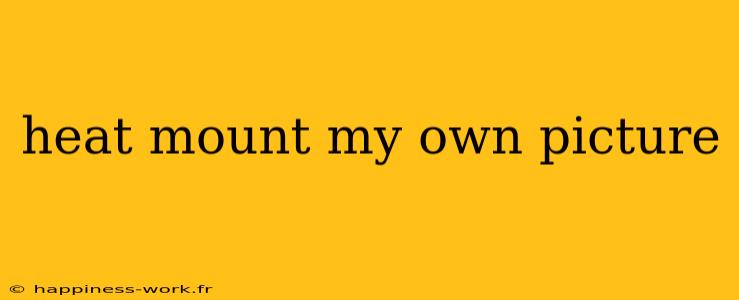Heat mounting is a popular technique used to adhere photographic prints or artwork to a sturdy backing without causing damage to the image. This method is favored by professional photographers and artists alike because it provides a clean and professional finish. In this guide, we'll explore the process of heat mounting your own picture, ensuring that your artwork looks its best while also providing insights and tips to optimize the outcome.
What is Heat Mounting?
Heat mounting involves using a heated press or iron to adhere a picture to a backing board. The process typically requires a heat-activated adhesive that bonds the image to the board, resulting in a flat and durable finish. This method is ideal for various types of prints, including photographs, digital prints, and artwork.
Why Choose Heat Mounting?
- Professional Finish: Heat mounting results in a sleek look that enhances the presentation of your work.
- Durability: The bonding process creates a long-lasting mount that protects the artwork from warping or curling.
- Ease of Use: With the right tools, heat mounting can be done at home, making it an accessible choice for artists and photographers.
What You Need
Before you start the heat mounting process, gather the following materials:
- Artwork: Your picture or print.
- Backing Board: Choose a sturdy material, such as foam board or MDF.
- Heat-Activated Adhesive: Special mounting adhesives are designed for this purpose.
- Heat Press or Iron: A heat press is preferred for consistent heat, but an iron can work in a pinch.
- Protective Sheet: Use a piece of parchment paper or a Teflon sheet to protect your artwork from direct heat.
- Roller or Brayer: This is used to smooth out bubbles during the mounting process.
Step-by-Step Process to Heat Mount Your Picture
-
Prepare Your Workspace: Ensure you have a clean, flat surface to work on. Lay out all your materials for easy access.
-
Cut the Backing Board: Measure and cut your backing board to the desired size, ensuring it is slightly larger than your print.
-
Apply Adhesive: Lay your print face down on your workspace. Apply a thin, even layer of heat-activated adhesive to the backing board.
-
Align and Press: Carefully position your print face up on the adhesive-coated board. Use the roller to remove any air bubbles, starting from the center and working outward.
-
Cover and Heat: Place a protective sheet over your artwork, then apply heat using your heat press or iron. If using an iron, set it to the appropriate temperature based on the adhesive instructions and avoid using steam. Apply consistent pressure for the recommended time.
-
Cool and Trim: Once cooled, carefully trim any excess backing board that extends beyond the edges of your artwork for a neat finish.
-
Final Touches: Optionally, you can frame your mounted picture or add hanging hardware to the back for easy display.
Tips for Successful Heat Mounting
- Test First: If this is your first time using a specific adhesive, consider testing it on a scrap piece to understand the heat and pressure needed.
- Check Temperature: Use a heat gun or thermometer to ensure that your heat source is at the correct temperature for the adhesive.
- Work Quickly: Once the adhesive is heated, you should work quickly to place the image to ensure proper bonding.
Additional Considerations
- Different Materials: Different types of prints and boards can yield varying results. For example, glossy prints may require different heat settings than matte prints.
- Storage: Properly store your finished mounted pictures in a cool, dry place to prevent moisture damage.
- Alternative Methods: If you don’t have a heat press or iron, consider using adhesive sprays or double-sided tape as alternatives for mounting, although they may not offer the same durability.
Conclusion
Heat mounting your own pictures can elevate your artwork and provide a professional touch to your prints. By following the outlined steps and tips, you can achieve a durable and aesthetically pleasing finish that enhances the visual appeal of your work. Don't hesitate to experiment with different techniques and materials to find what works best for you.
For further reading and visual references, check out the original questions and answers on WikiHow written by authors who focus on practical DIY techniques. By adapting their guidance with the insights provided in this article, you'll be well-equipped to master the art of heat mounting.
This markdown format includes headings, bullet points, and a concise structure to enhance readability and SEO optimization, making it easy for readers to navigate through the content.
